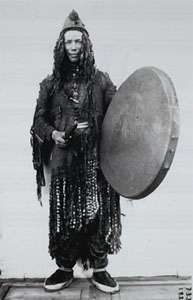Ymyyakhtakh culture
The Ymyyakhtakh culture (Russian: Ымыяхтахская культура) was a Late Neolithic culture of Siberia, with a very large archaeological horizon, dating to c. 2200–1300 BC. Its origins seem to be in the Lena river basin of Yakutia, and also along the Yenisei river. From there it spread both to the east and to the west.[1] Individual sites were also found in Taymyr.

It is named after Ymyyakhtakh, a settlement in the Sakha Republic, Russia.
Description
A. Golovnev discusses Ymyyakhtakh culture in the context of a “circumpolar syndrome”,
- "... some features of the East Siberian Ymyyakhtakh culture spread amazingly quickly as far as Scandinavia. Ceramics with wafer prints are found at the Late Bronze Age monuments of the Taimyr Peninsula, Yamal Peninsula, Bolshezemelskaya and Malozemelskaya tundra, the Kola Peninsula, and Finland (not to mention East Siberia and North-East Asia)."[2]
A distinctive feature of the culture is the round-bottomed ceramics with waffle and ridge prints on the outer surface. Stone and bone arrowheads, spears and harpoons are richly represented. Armour plates were also used in warfare.
Finds of bronze ware are frequent in the burial grounds.
The culture was formed by the tribes migrating from the shores of Lake Baikal to the south, merging with the local substrate of the Bel'kachi culture.
The carriers of culture are identified either with the Yukagirs ethnic group, or perhaps with the Chukchi and Koryaks. The Ymyyakhtakh culture continued at least until the first centuries of our era. It was later replaced by the Ust-Mil culture.
Migrations
After 1,700 BC, the Ymyyakhtakh culture is believed to have spread to the east as far as the Chukotka peninsula, where it was in cultural contact with the Eskimo-Aleut language speakers, and the Paleo-Eskimos.[3]
A ceramic complex comparable to the Ymyyakhtakh culture (typified by pottery with an admixture of wool) is also found in northern Fennoscandia towards the end of the second millennium BC.[4]
See also
References
- Kicki Näslund, Short summary of Siberian pre-history and cultures - Academia.edu
- Russian: Головнев А. В., Кочевники тундры: ненцы и их фольклор. — Екатеринбург: УрО Ран, 2004
- Pavel Flegontov et al, Na-Dene populations descend from the Paleo-Eskimo migration into America. doi:10.1101/074476
- Козлов, А. И.; Лисицын, Д. Д. (2008). "Происхождение, этническая история и традиционное природопользование саамов". In Козлов, А. И.; Лисицына, Д. В.; Козловой, М. А. (eds.). Кольские саамы в меняющемся мире (in Russian). Москва: Институт Наследия, ИЛ «АрктАн-С». p. 14. ISBN 978-5-86443-148-1.
Further reading
- Fedoseeva S. A. The Ymyakhtakh Culture of Northeastern Asia